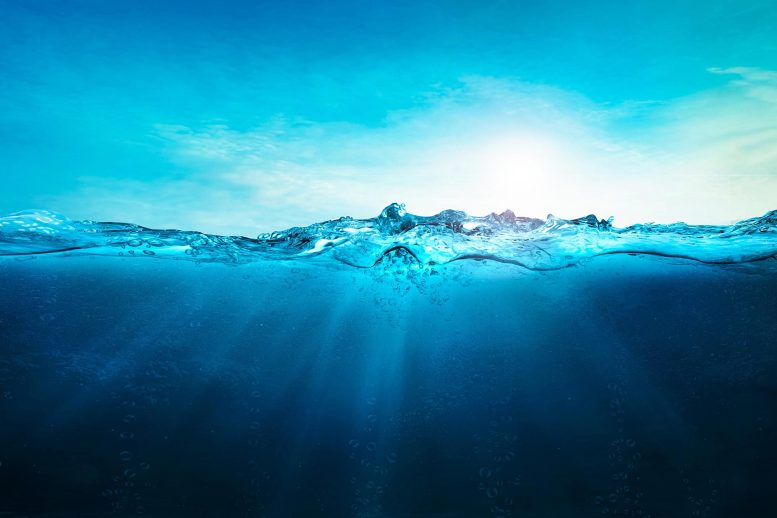
The oceans absorb carbon dioxide and play a critical role in reducing global warming. However, according to a study by The University of Texas at Austin, as the oceans continue to warm in the future, their ability to absorb CO2 will decline, leading to more severe warming. The study’s climate simulation suggests that the oceans’ maximum capacity to absorb CO2 will be reached by 2100 and will drop to half of its current efficiency by 2300 under a worst-case emissions scenario.
The oceans play a crucial role in mitigating global warming by absorbing carbon dioxide emissions. However, researchers have found that as the oceans warm up in the future, their capacity to absorb CO2 could decrease, leading to even more severe warming.
In a study conducted by The University of Texas at Austin, researchers found that the oceans’ capacity to absorb carbon dioxide (CO2) would reach its maximum by 2100 and decrease to half of its current efficiency by 2300, based on a climate simulation that was configured for a worst-case emissions scenario.
The decline happens because of the emergence of a surface layer of low-alkalinity water that hinders the ability of the oceans to absorb CO2. Alkalinity is a chemical property that affects how much CO2 can dissolve in seawater.
Although the emissions scenario used in the study is unlikely because of global efforts to limit greenhouse gas emissions, the findings reveal a previously unknown tipping point that if activated would release an important brake on global warming, the authors said.
“We need to think about these worst-case scenarios to understand how our CO2 emissions might affect the oceans not just this century, but next century and the following century,” said Megumi Chikamoto, who led the research as a research fellow at the University of Texas Institute for Geophysics.
The study was published in the journal Geophysical Research Letters.
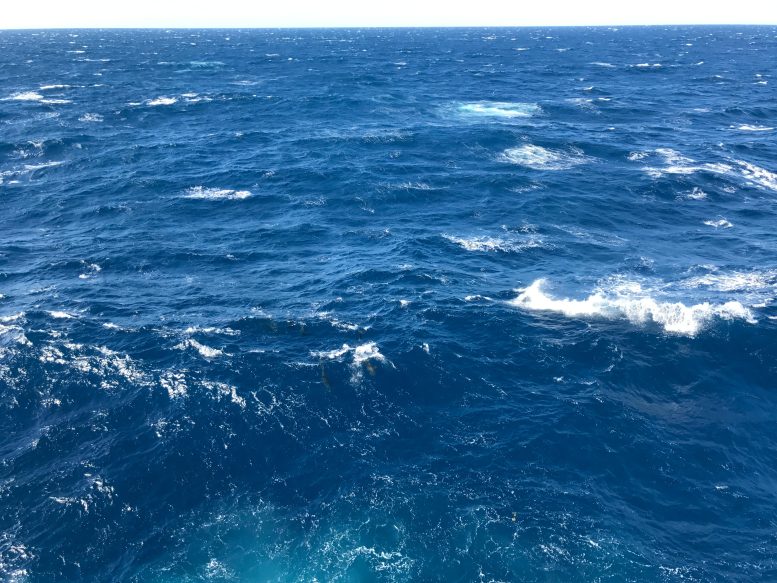
Choppy seas over the Gulf of Mexico, 2017. Research led by the University of Texas Institute for Geophysics found that future warming could trigger chemical changes in the ocean surface that accelerate global warming. Credit: Jackson School of Geosciences/Tiannong “Skyler” Dong
Today, the oceans soak up about a third of the CO2 emissions generated by humans. Climate simulations had previously shown that the oceans slow their absorption of CO2 over time, but none had considered alkalinity as an explanation. To reach their conclusion, the researchers recalculated pieces of a 450-year simulation until they hit on alkalinity as a key cause of the slowing.
According to the findings, the effect begins with extreme climate change, which supercharges rainfall and slows ocean currents. This leaves the surface of the oceans covered in a warm layer of fresh water that won’t mix easily with the cooler, more alkaline waters below it. As this surface layer becomes more saturated with CO2, its alkalinity falls and with it, its ability to absorb CO2. The end result is a surface layer that acts as a barrier for CO2 absorption. That means less of the greenhouse gas goes into the ocean and more of it is left behind in the atmosphere. This in turn produces faster warming, which sustains and strengthens the low-alkalinity surface layer.
Co-author, Pedro DiNezio, an affiliate researcher at the University of Texas Institute for Geophysics and associate professor at the University of Colorado, said that the discovery was a powerful reminder that the world needs to reduce its CO2 emissions to avoid crossing this and other tipping points.
“Whether it’s this or the collapse of the ice sheets, there’s potentially a series of connected crises lurking in our future that we need to avoid at all costs,” he said. The next step, he said, is to figure out whether the alkalinity mechanism is triggered under more moderate emissions scenarios.
Coauthor Nikki Lovenduski, a professor at the University of Colorado who contributed to the Intergovernmental Panel on Climate Change 2021 climate report, said that the study’s findings would help scientists make better projections about future climate change.
“This paper demonstrates that the climate change problem may be exacerbated by things that are as yet unknown,” she said. “But the ocean climate feedback mechanism this particular study revealed will open up new avenues of research that will help us better understand the carbon cycle, past climate change and perhaps come up with solutions for future problems.”
Reference: “Long-Term Slowdown of Ocean Carbon Uptake by Alkalinity Dynamics” by Megumi O. Chikamoto, Pedro DiNezio and Nicole Lovenduski, 9 January 2023, Geophysical Research Letters.
DOI: 10.1029/2022GL101954
The study was funded by the National Science Foundation.
UTIG is a research unit of UT Jackson School of Geosciences.



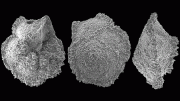
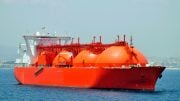
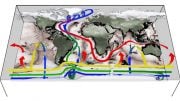


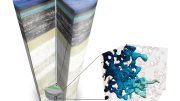
I have to congratulate the authors for using the term alkalinity instead of the more usual but erroneous term acidity. They do mention acidification a few times, but this is still an improvement over most climatology articles where the authors appear to have expunged alkalinity from their vocabulary.
In simple solutions, for what might be called titration neutrality, the proton donors (hydronium ions [+1]) and proton acceptors (hydroxyl ions [-1]) have equal abundance; this occurs at pH 7. For more complex, buffered solutions, the point of neutrality will usually be shifted. In the case of sea water, the point at which the solution changes behavior is at about pH 7.5. The point being, an acid solution behaves differently from an alkaline solution, and it is the ratio of the hydronium and hydroxyl ions that determine the behavior. When the two species of ions are equal, the solution is considered to be neutral. Basically, all that one needs to know about sea water buffering can be obtained from a Bjerrum Plot: https://en.wikipedia.org/wiki/Bjerrum_plot
and keep in mind that the left of the diagram represents acidic water and the right represents alkaline water. And from a grammatical point of view, more of nothing is a logical contradiction. Thus, saying that an alkaline solution is becoming more acidic is an oxymoron. It is, instead, just experiencing a lowering of the pH.
Most of the time when a measurement is graphically plotted against some other variable, the vertical axis (ordinate) increases upwards, and the horizontal axis (abscissa) increases to the right. Based on that convention, the pH plot should be considered a plot of alkalinity, not acidity, because alkalinity increases to the right and the numbers similarly increase to the right. Even though it is the hydronium ion whose abundance is measured, it is displayed as the negative logarithm. However, one could have used hydroxyl, because the two species have an inverse relationship.
The important thing to keep in mind is that it is the RATIO of the two species that determines the chemical behavior of of the solution; the behavior changes at about pH 7.
The Bjerrum Plot shows that there is plateau of stability for bicarbonate between about pH 6.5 and pH 8.5; nobody is predicting that the bulk pH of the open oceans will ever even reach pH 7.
The article suggests that a thin film of water with lowered pH will act as a barrier to absorbing CO2 in the future. Actually, that already happens with large diurnal and seasonal changes in both pH and, especially, salinity. The denser saline water sinks, mixing the surface film with underlying water. There is also evidence suggesting that tropical thunderstorms keeps the water to less than 30 deg C, and the storm winds keep the surface roiled.
Most climate alarmists predict more extreme weather as the globe warms. If they are correct, then the surface film will be disrupted by these more frequent and severe storms, nullifying the predicted effect.
Models can be useful to help understand complex systems. However, most modelers are unfamiliar with Chamberlain’s Method of Multiple Working Hypotheses and put too much stock in what their ‘beautiful little babies’ spit out.
“Although the emissions scenario used in the study is unlikely because of global efforts to limit greenhouse gas emissions,” yada, yada, yada. Definitely more lies to tone down the reality of what this means.
If the oceans are to reach ‘maximum absorption’ under the worst-case scenario (which keeps coming true) in less then 80 years – did they “model” what it means to the Earth and planetary habitability as the remaining absorption declines? No?
This is the problem with modeling (siloing information) that keeps coming up, again and again. Are we to presume that Earth’s still habitable at say 95% maximum absorption? 90%? When does the total level absorption become unlivable?
Anyone paying attention (not Spencer) knows that the worst-case continues to be presented more and more, and the lip-service to limit greenhouse gas emissions isn’t having any effect to-date. Emissions continue to go up, proving the worst-case scenarios are increasingly likely (unfolding reality).
So the question remains – what is the maximum survivable level of ocean absorption? And what is that projected date? What will be the effects of maximum absorption?
“Anyone paying attention (not Spencer) knows that the worst-case continues to be presented more and more, …”
Do you have a citation that supports your assertion? Or, is that just your subjective opinion? For those who DO continue to use the RCP8.5 scenario, after Curry et al. have shown it to be improbable, and even the numerous models show that the worst-case scenario model-outputs are not close to tracking actual temperatures, it calls into question their objectivity. While, admittedly, RCP8.5 was intended to be “business as usual,” it appears to have been poorly formulated because it has never conformed to historical temperatures, despite there being little effective reduction in CO2 emissions, as you state.
Then there is the issue of when there WAS a reduction in annual anthropogenic emissions (2020) of about 10% (18+% reduction, monthly maximum in April) there was no discernible decline in the seasonal rate of increase, the annual high, or the net annual gain, calling into question the role that anthro’ emissions play in the Carbon Cycle.
“When does the total level absorption become unlivable?”
That is an interesting question. It would appear that your unstated assumption is that there is some hypothetical ‘Tipping Point’ at which life will suddenly come under existential threat. I don’t think that there is much evidence to support that.
In one of his Nature series, David Attenborough remarks that the Tropics compose about 1% of the land surface of Earth, but supports 50% of known species. The Paleocene-Eocene Thermal Maximum was a time of rapid evolution of mammals, allowing them to re-populate the ecological niches left with the demise of dinosaurs, which lived in a period of greater warmth than today. There was a recent article here on SciTechDaily [ https://scitechdaily.com/gigantic-ant-fossil-with-a-6%e2%80%b3-wingspan-raises-questions-about-ancient-arctic-migrations/ ] that remarks “The scientists found that the ancient climates were hot where these ants lived in Wyoming and Europe. They further found that modern ants with the biggest queens also inhabit hot climates, leading them to associate large size in queen ants with high temperatures.” Clearly, things would be different in a warmer world, but there is little reason to believe that it would be “unlivable.”
Hand waving and wing flapping do not turn possibilities into probabilities.
I stumbled upon it on GG. I will come back once again. This blog is definitely rather handy.
Your amazing insightful information entails much to me and especially to my peers.
I gotta favorite this website it seems very helpful.